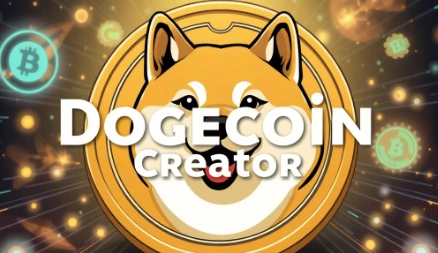Dogecoin Creator – Who Is it?
Table of Contents

Dogecoin, the meme cryptocurrency that started as a joke, has become one of the most talked-about digital assets in the crypto world. Its Shiba Inu mascot and unique origin story have captured the attention of millions of crypto enthusiasts. But who exactly was Dogecoin created, and why did it take off? If you’re curious about the history behind this iconic cryptocurrency, you’re in the right place.
For more insights and updates on the latest trends in crypto, be sure to check out our Nifty Finances platform, which is your gateway to smarter financial decisions in the digital economy.
The Birth of Dogecoin: A Fun and Playful Start
Dogecoin was created in 2013 by two software engineers: Billy Markus and Jackson Palmer. The creation of Dogecoin was a response to the rapid rise in popularity of Bitcoin and the growing interest in cryptocurrencies. However, Markus and Palmer weren’t setting out to create the next major digital currency. Instead, Dogecoin was born as a fun, lighthearted alternative to the increasingly serious world of cryptocurrency.
Here’s how it all happened:
- Billy Markus, a programmer at IBM, wanted to create a cryptocurrency that was more approachable and fun than Bitcoin. He was inspired by the popularity of the Doge meme (a Shiba Inu dog with captions in broken English), which had gone viral online.
- Jackson Palmer, a product marketing manager at Adobe, had purchased the domain name dogecoin.com as a joke, and later partnered with Markus to bring the project to life.
Together, they created a fork of Litecoin, which was faster and cheaper to mine than Bitcoin. The Dogecoin blockchain was designed to produce new coins quickly and in large quantities, making it easier for everyday users to participate in mining. The result was a light-hearted, community-driven cryptocurrency that didn’t take itself too seriously.
Why Did Dogecoin Gain Popularity?
Despite its beginnings as a joke, Dogecoin gained massive popularity over the years. The key to Dogecoin’s success lies in several factors:
- Community Engagement: Dogecoin’s success was fueled by its enthusiastic community. Dogecoin holders and users came together for fun, charity events, and even to sponsor the 2004 Jamaican bobsled team for the Winter Olympics.
- Low Transaction Fees: With low transaction fees and quick transaction times, Dogecoin became a popular choice for microtransactions and tipping content creators online. Its accessibility made it an attractive alternative to Bitcoin and other major cryptocurrencies.
- Celebrity Endorsements: The influence of Elon Musk, the billionaire CEO of Tesla and SpaceX, has also played a massive role in driving Dogecoin’s popularity. Musk’s playful tweets and support for Dogecoin helped boost its price and solidified its status as more than just a meme coin.
What Happened to the Dogecoin Creator?
After the success of Dogecoin, both creators have taken different paths:
- Billy Markus:
Billy Markus, one of the co-founders of Dogecoin, stepped away from the project early on. He stated in interviews that he sold all his Dogecoin holdings in 2015 and moved on from the project. Although he’s no longer actively involved with Dogecoin’s development, Markus has remained an advocate for the community, often sharing his thoughts on social media. - Jackson Palmer:
Similarly, Jackson Palmer distanced himself from Dogecoin and the cryptocurrency world in general. He left the project in 2015, citing the growing commercialization of the cryptocurrency industry. Palmer has been vocal about his disillusionment with the market and the influence of corporate interests in the space.
Despite their departure from the project, both Markus and Palmer have played an essential role in Dogecoin’s rise to fame. While they may no longer be actively involved, they remain part of the Dogecoin legend.
Dogecoin Today: More Than Just a Meme Coin
In recent years, Dogecoin has shed its label as a “meme coin” and gained recognition as a legitimate digital asset. Dogecoin’s market capitalization has surged, and its active community continues to support and drive its development. Elon Musk’s support and Dogecoin’s use in microtransactions and charitable donations have pushed the cryptocurrency into the spotlight.
Dogecoin’s inflationary model, unlike Bitcoin’s capped supply, means that new coins are continuously minted, which ensures that the price remains accessible for new miners and users. Its ease of use and active online community have made Dogecoin a favored asset for cryptocurrency enthusiasts.
What Does the Future Hold for Dogecoin?
As for the future of Dogecoin, much remains to be seen. While its creators are no longer actively involved, Dogecoin’s community remains strong and vibrant. Elon Musk continues to be a vocal supporter, and the meme coin’s use in charity events and online tipping is still growing.
As Dogecoin continues to grow, it may move beyond just being a joke or meme coin. Its use as a payment method, especially with Elon Musk’s push to integrate Dogecoin into Tesla’s payment options, could push the coin into mainstream adoption. However, with its inflationary supply and lack of development from its creators, Dogecoin’s long-term value remains uncertain, and investors should always be aware of the risks.
Should You Invest in Dogecoin?
If you’re considering investing in Dogecoin, it’s important to keep its origins and volatility in mind. While Dogecoin’s community and celebrity endorsements give it a unique edge, its market fluctuations can be unpredictable. As with any cryptocurrency, conduct thorough research and understand your risk tolerance before diving in.
Dogecoin was created as a fun, lighthearted project by Billy Markus and Jackson Palmer, but its rise to fame and mainstream popularity has taken the cryptocurrency world by surprise. While the original creators have since moved on, Dogecoin’s enthusiastic community continues to drive its growth. Whether you’re a Dogecoin investor or simply interested in its origins, understanding the story behind its creation adds an interesting layer to this meme-turned-crypto asset.